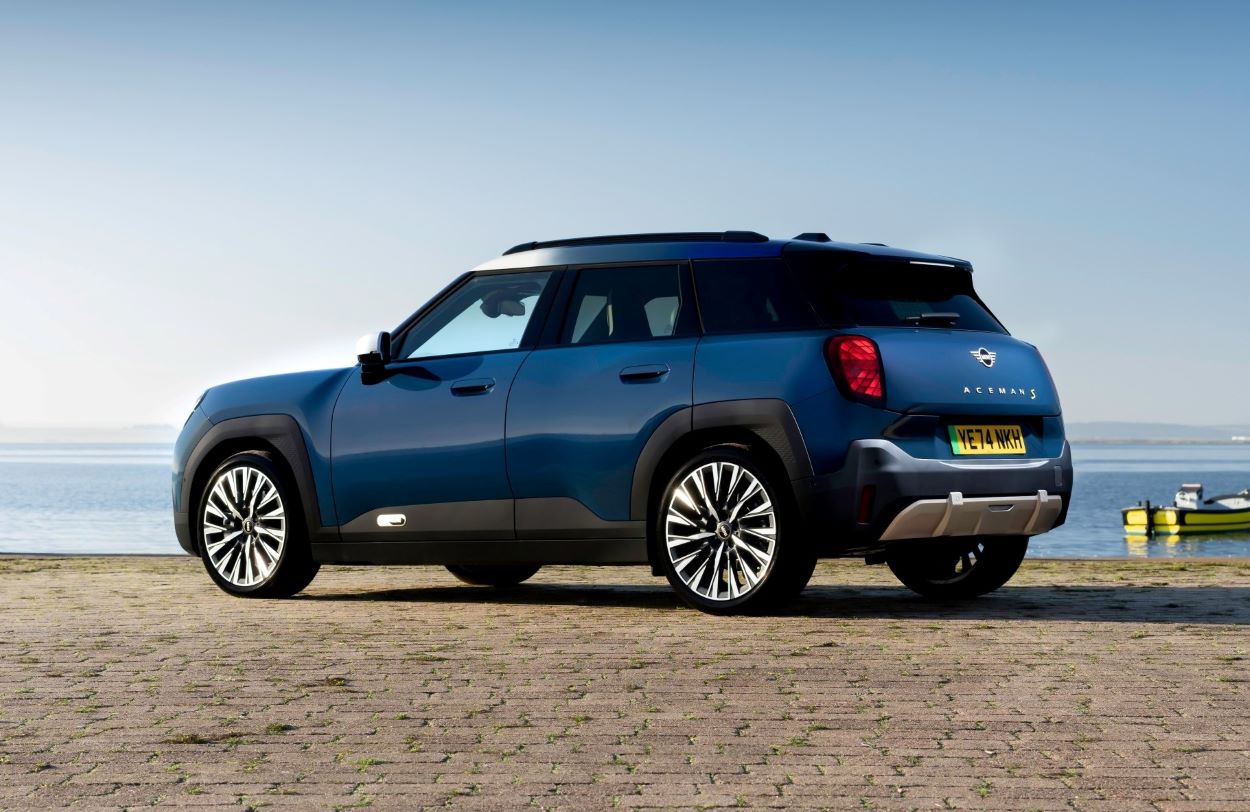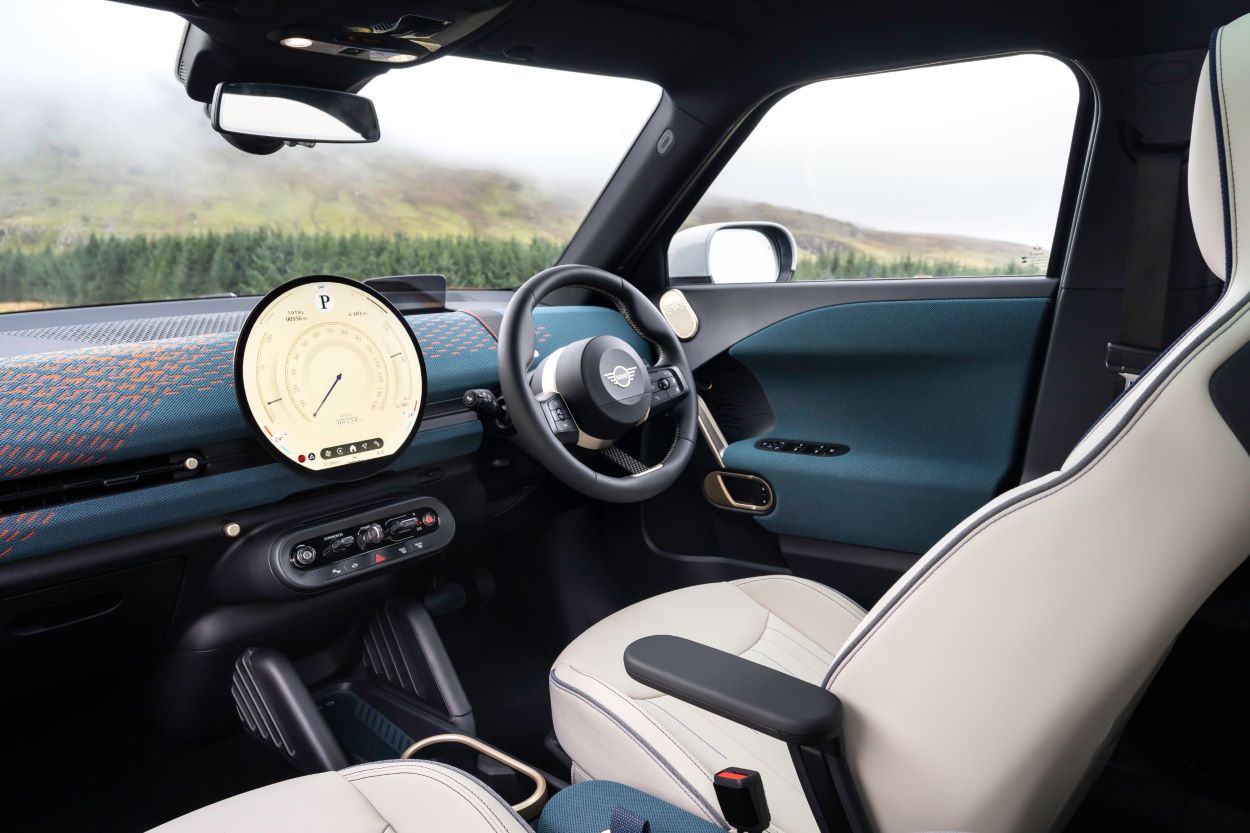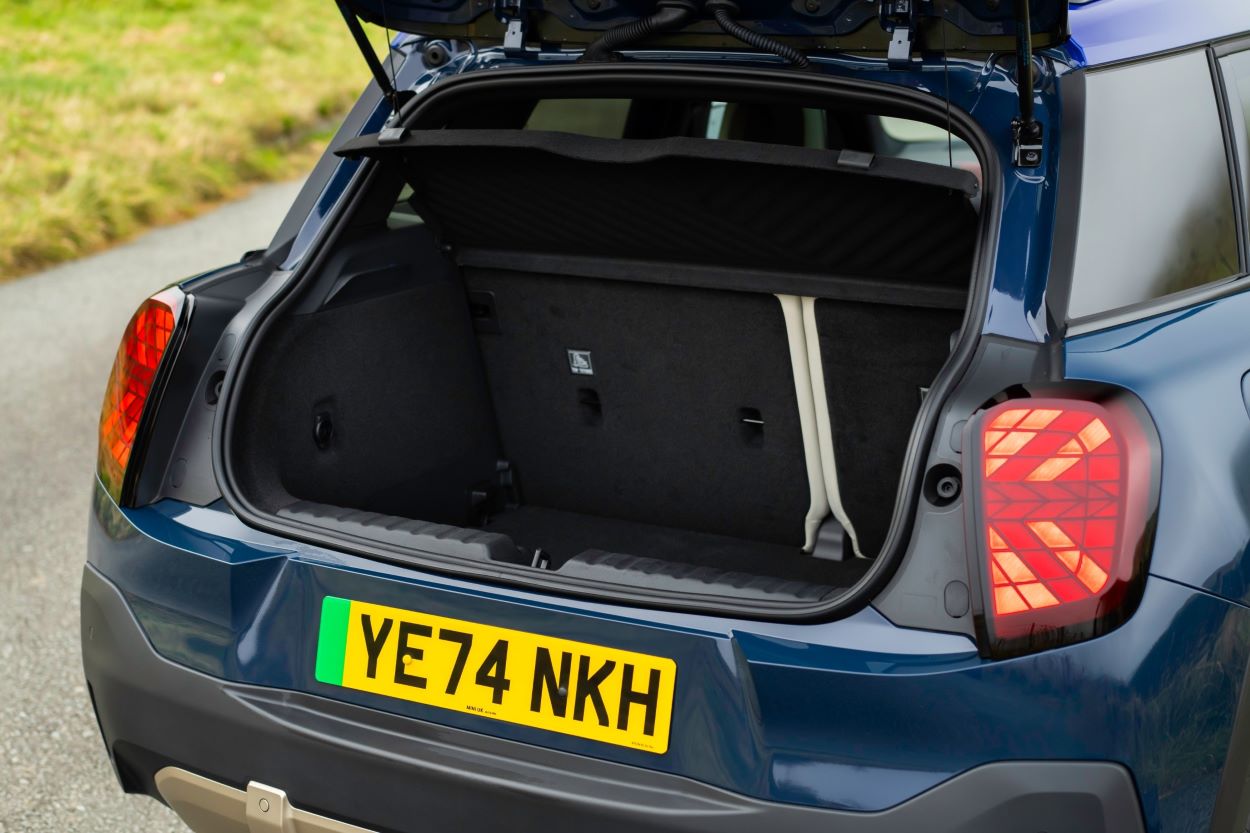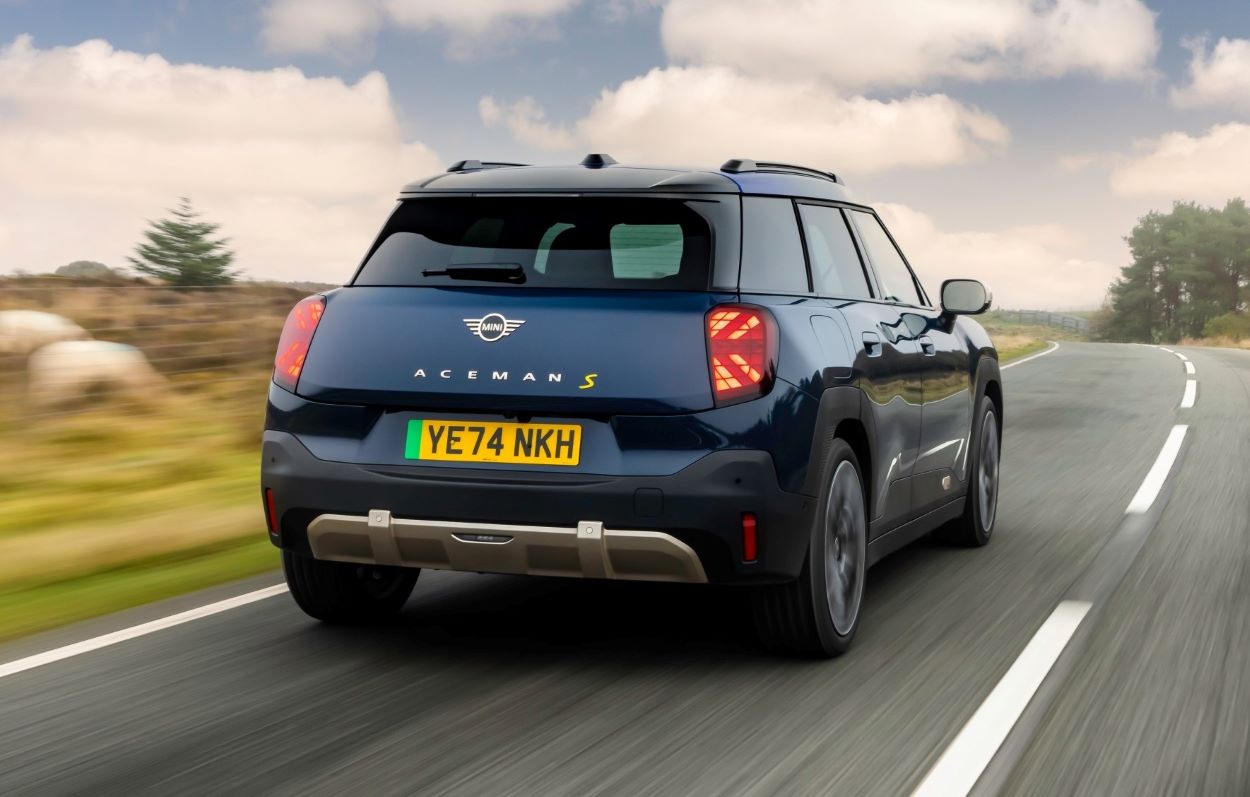
RAC sale – up to 33% off*
• Roadside cover from £5.29 a month†
• We get to most breakdowns in 60 mins or less
• Our patrols fix 4/5 breakdowns on the spot

The expanding Countryman frees up room for a smaller, electric-only MINI SUV called the Aceman. Is it any good? Lawrence Allan finds out.
Things you'll like
- Funky design inside and out
- Fun to drive
- Affordable to run
Things to consider
- Range and charging speeds are nothing special
- Not overly practical
- Firm ride
What is the MINI Aceman?
Well, it’s no relation to the old, short-lived MINI Paceman, if the brand’s range changes of the last decade or so are a bit confusing to you. The Aceman is both all-new and all-electric, but requires some explaining.
You see, like many carmakers the half-British, half-German brand’s models have grown in size over the last 15 years. It’s probably more noticeable when your brand name is a synonym for ‘small’. The MINI Countryman illustrates this growth most clearly, with the new Mk3 model being over 4.43m long and 1.84m wide.
Granted, that doesn’t exactly make it a BMW X5, but when the original MINI Countryman of 2010 was under 4.1m long and 1.79m wide the quick growth spurt is very apparent. It’s gone from a rugged small hatchback to a fully-fledged SUV – which is where the Aceman fits in.
Its dimensions are conveniently close to that original Countryman. What’s more, the Aceman kills two birds with one stone, not just by providing the truly compact crossover the market needs, but also by replacing the old MINI Hatch 5dr - thus ensuring the diddy new Cooper Electric 3dr doesn’t need to be stretched out of all recognition.
Like the Cooper Electric, the Aceman is Chinese-built as part of a joint venture with Great Wall Automotive (it will be built in the UK in 2026). It’s also only available as an EV. Is the Aceman the perfect compromise between the compact size of a hatch and the rugged look of an SUV? We’ll find out in this review.
Verdict: is the MINI Aceman a good car?
The Aceman is no fully-fledged SUV by any stretch – viewed as a longer five-door version of the Cooper Electric with some rugged styling cues it makes more sense. It’s fun to drive, offers peppy performance and a bold, high-quality interior with clever – if sometimes fiddly – tech.
Viewed in this respect the Aceman is a fine product, but it probably won’t cut it as a sole family car thanks to limited practicality and boot space. The ride is also on the firm side, while bigger rivals with longer ranges cost similar money.
Pricing, specs & rivals
As of January 2025, list prices for the MINI Aceman kick off at £31,920 for the entry-level E Classic model. That slightly undercuts the Volvo EX30 and the bigger Kia EV3 but is roughly in line with the Smart #1 and more expensive than the Jeep Avenger.
Upgrading to Exclusive spec moves the list price us to £34,670, while Sport trim is £35,970. From there, the bigger battery Aceman SE kicks off from £36,420 in Classic spec, £39,170 in Exclusive and £40,470 in Sport – crossing the crucial £40k barrier that brings with it the Expensive Car Supplement tax.
Topping the range is the MINI Aceman John Cooper Works, only offered in Sport trim, which adds a reasonable £1,000 to the list price of the Aceman SE Sport.

Considered in list price terms alone (bear in mind PCP figures can vary) the Aceman makes more sense financially in its lower specs. Start moving up the range (or plunging the extensive options list) and it creeps uncomfortably close to the MINI Countryman Electric, and a host of other bigger and much longer-range rivals.
In terms of standard kit, the Aceman E Classic gets a decent enough tally including LED lights front and rear, roof rails, 17-inch alloys (made in part with recycled aluminium) dual-zone climate control, ambient lighting, a heated steering wheel, sat-nav and cruise control. Exclusive and Sport trims don’t actually add more features, mainly focusing on styling upgrades and further paint and upholstery options.
Upgrading to the Aceman SE doesn’t just give you a bigger battery – you also get the ‘Level 1’ option pack as standard. That brings adaptive LED headlights with auto high beam and customisable light signatures, heated front seats, power folding mirrors, keyless entry, wireless phone charging and a head-up display. There are two further option pack levels that add further niceties.
Rivals
There’s a good number of rivals for the MINI Aceman, some with premium badges and some without. A key competitor is the Fiat 600e – a similarly retro-styled electric small SUV – and its closely related sibling, the Jeep Avenger. You might also want to consider the Peugeot e-2008, and if a hatchback is more your thing the BYD Dolphin, too.
Elsewhere, options like the new Kia EV3, along with the slightly bigger Niro EV and Hyundai Kona Electric, are worth considering as roomier alternatives. The Volvo EX30 is more the MINI’s size, but counters with a much longer range, while the larger Smart #1 is well worth a look.
MINI Aceman: Interior comfort, quality & technology
Don’t expect to be lording it over other motorists with an SUV-style driving position in the Aceman – you’ll want the Countryman for that. You do at least sit higher up than you do in the Cooper Electric, giving you a better view out, but it’s more like sitting in a small hatchback.
Lack of a commanding view aside, the driving position is well-sorted thanks to a good positioning of the seat, wheel and pedals, plus a decent amount of adjustability. Chunky side bolsters give the Aceman a sporty feel, although it’s a shame lumbar adjustment is restricted to the expensive Level 3 option pack.
A narrow rear window restricts your rearward view, but visibility otherwise is pretty good – and you get all-round parking sensors and a rear-view camera across the range to help with parking.
Elsewhere, the Aceman’s cabin will be very familiar if you’re used to the new-age Cooper Electric. It’s a bold, love-or-hate design with watchstrap-like elements and lots of knitted fabric textures on the dash and doors – these can be had in bold colours in Exclusive and Sport trim, with Classic a slightly duller affair.
It’s an expressive cabin, despite the minimalist approach to switchgear, and quality seems good overall. What buttons and knobs there are feel of good quality, while there are only cheaper plastics found in the lower reaches of the cabin – everywhere else feels suitably upmarket. Only the somewhat ugly armrests lower the tone a touch.

Infotainment, sat-nav, stereo and connectivity
Like the Cooper and Countryman, the Aceman’s dash is dominated by a circular infotainment touchscreen that’s 9.4 inches in diameter. Pretty much every major function is controlled through this screen.
What strikes you first is how impressively high-resolution the screen and its graphics are – it makes the square screens in some alternatives look very old-hat. There are bold colours and changeable themes to suit your tastes, with some of these themes linked to the car’s drive modes and artificial sound generator.
The sharp graphics, decent response times and wealth of features give a good first impression, but the more time you spend with the Aceman’s touchscreen, the more your realise that some of the icons are fiddly to use on the move. You also get a lot of information all at once, which is fine when stationary but tricky to pick out at a glance on the move.
That takes some getting used to, particularly as (like the Volvo EX30 and Teslas) the Aceman has no instrument display above the steering wheel. If you don’t opt for the Aceman SE (or the Level 1 pack on the Aceman E) you won’t get the excellent head-up display. This means you’re forced to look to your left at the centre screen just to check your speed.
In terms of connectivity you get wireless Android Auto and Apple CarPlay smartphone mirroring, which works well apart from it not being correctly formatted for the circular screen. It instead displays as a square section within the screen, which isn’t ideal when using navigation apps, for example. Also standard is an e-Sim and remote services via a smartphone app.
You also get four USB-C ports (two at the front and two at the rear) to charge devices with, plus you can spec tablet holders for the rear seats. As for sound, we’ve only tried the optional 10-speaker, 315-watt Harman Kardon sound system, which is pretty punchy for a small car.
How practical is the MINI Aceman
We’d stress that you think of the MINI Aceman as a stretched Cooper Electric with five doors instead of three, because this is no full-sized family car in terms of outright space. The Aceman’s dimensions make it 4.08m long, 1.75 m wide and just 1.51m tall – hardly making it an SUV in the conventional sense.
Up front you get a taller and wider cabin than the Cooper Electric, with a decent amount of leg and headroom for a pair of six footers. It’s not an especially airy cabin, though, with MINI preferring a more cocooned cockpit-like feeling. Something like a Smart #1 feels far roomier, and wider too.
Having back doors is a huge boon over the three-door hatch, meaning you don’t have to get out to let rear passengers out and it’s much less of a squeeze to get in the back. Actual space is acceptable rather than generous – headroom is only a squeeze for those over six foot, and four six-footers will need to compromise to fit in.
Overall, the Aceman’s space is about on a par with the Jeep Avenger, Fiat 600e and Volvo EX30, but it’s some way short of the space a Hyundai Kona Electric or BYD Dolphin offers.
Storage and boot space
You get a decent amount of oddment storage in the Aceman, but most of it is confined to the centre console tray which runs through the cabin into the rear seats.
This tray features a pair of cupholders and a lidded cubby space, and it’s great for chucking in phones and wallets knowing they can’t fall out due to the raised sides. However, it comes at the expense of more typical storage areas: the armrest is mounted to the seat so has no storage, the door bins are pretty tiny and the glovebox isn’t generous.
Having that centre console extend back into the rear seats is great, because you’ll need its cupholder as the rear door bins are hilariously small. You do at least get some pockets in the front seat backs, but there are no armrest cupholders either.
The Aceman’s rear backrests do at least fold, but only in a 60/40 split (typical for a car of this size) while the bench itself doesn’t slide to juggle boot space or legroom.
Boot space isn’t much to write home about either, with a 300-litre capacity. While that might be 90 litres more than the Cooper Electric, and slightly bigger than a Smart #1, it’s some way short of the space offered by many larger alternatives for the same money. There’s also a high load lip to deal with, but the load space is at least well-shaped.

Performance & drive: What is the MINI Aceman like on the road?
For most people, we reckon the entry-level183hp MINI Aceman E offers ample performance for most road situations. Its only limiting factor is its range on a charge.
The E’s 0-62mph time of 7.9 seconds isn’t exactly thrilling, but it’s faster than the entry-level Hyundai Kona Electric, Jeep Avenger and Peugeot e-2008. What’s more, the instant delivery of the electric motor’s full power means it feels faster than that on-paper figure suggests.
Upgrading to the Aceman SE is more about the extra battery capacity than rip roaring pace, but there’s a useful boost – up to 218hp with the 0-62mph dropping to 7.1 seconds. With power going to the front wheels only, it’s quicker than the Kia EV3 and feels usefully punchy out of town, if not exciting.
We’ve yet to drive the John Cooper Works version, which ups the power output to 258hp – if only for short bursts using a special boost mode. The 0-62mph time suggests it’s not vastly more rapid than the SE, and anyway it’s still a long way off dual motor alternatives such as the 428hp Smart #1 Brabus, while even an entry-level single motor Volvo EX30 is quicker than all Aceman variants.
The Aceman’s regenerative braking behaves naturally and kicks in smoothly when you lift of the throttle, while the brake pedal itself responds consistently. Our only gripe is that adjusting through the three strength levels of regen requires fiddling about with the touchscreen a bit much. Rivals with steering wheel mounted paddles are much easier to live with.
Power, 0-62mph times (H4)
- MINI Aceman E: 183hp/7.9 secs
- MINI Aceman SE: 218hp/ 7.1 secs
- MINI Aceman JCW: 258hp/ 6.4 secs
Ride and handling
On the road, the Aceman feels more like a stretched Cooper Electric than a shrunken Countryman. That gives it keen, agile handling that’ll be fun on the right road, but comes at the expense of outright comfort.
The sharp, feelsome steering, quick turn-in and tightly controlled body means you’d be hard pushed to feel the Aceman’s 1650kg+ kerbweight on the road. For the most part, it feels much livelier than that figure suggests.
The slight weight penalty of the Aceman SE isn’t as noticeable as it is in the Cooper Electric hatch. Sure, it’s ever so slightly less willing to change direction if you really concentrate, but that’s only if you’ve driven them back-to-back – it’s still an agile, enjoyable drive.
Then comes the trade-off. If you were expecting the Aceman to feel like a mature, grown-up small SUV over bumps you might be disappointed. It’s far firmer than something like a Kia EV3 or Volvo EX30, feeling a bit restless over poor surfaces and making potholes felt around town.
Find a smooth, well-surfaced faster road and the Aceman does eventually settle. Just be aware that the traditional MINI ‘go-kart feel’ can prove wearisome on long journeys.
Noise and refinement
The Aceman is reasonably refined at speed but not outstandingly so for this class of car. The electric motor stays near-silent most of the time, but road noise is noticeable (if not overly intrusive). There’s also a bit of wind rustle on motorways, but overall the Aceman isn’t too loud for long journeys.
As with other electric MINIs there are various sound effects that can be played under acceleration via different drive modes. Some do add to the sense of fun, making them ideal for spirited drives, but you’ll probably turn them off if you’re just cruising about.

Euro NCAP: is the MINI Aceman a safe car?
Euro NCAP has yet to put the MINI Aceman through its crash tests, so we’re not able to know if it matches the maximum five star rating its Countryman bigger brother managed. The more closely related MINI Cooper Electric has yet to be tested, either.
Still, there’s plenty of standard safety aids that should allow the Aceman to score well when it does get tested. The usual automatic emergency braking, lane keeping assistant and traffic sign recognition, while all Acemans also come as standard with blind spot monitoring, rear collision prevention and vehicle exit warning, too.
If you want adaptive LED headlights with auto high beam you’ll need the Level 1 option pack, with an assisted driving function (called Driving Assistant Plus) is only available with the Level 3 pack,
Charging, range and running costs
Given recent advances in electric car range – for example, Kia will sell you an EV3 with 375 miles of range on a charge for £36k – you might have expected a bit more from the Aceman.
Indeed, we were at least expecting a bit more range than the Cooper Electric, but no – the Aceman E manages up to 192 miles in official tests, with the Aceman S promising up to 251 miles.
That’s down to the size of the batteries. The Aceman E’s 38.5kWh usable capacity is less than half that of an EV3 Long Range, and only 2kWh bigger than the Cooper E’s battery. Stepping up to the Aceman SE brings you a 49.2kWh usable pack (the same as a Cooper SE).
While the Aceman’s modest pack sizes bring plenty of benefits (lighter weight, greater efficiency, lower cost, faster charge times) you might hope for a version that gets close to 300 miles of range.
Still, the Aceman SE compares well to the Jeep Avenger and Fiat 600e, while also beating out the entry-level Volvo EX30 by 48 miles despite both having the same battery size. It also isn’t far behind the Smart #1 Pro+, while the clearly more town-focused Aceman E is a match for the entry-level #1.
Range on a charge (WLTP figures)
- MINI Aceman E: 192 miles
- MINI Aceman SE: 251 miles
As we mentioned, the trade-off for the Aceman’s small battery sizes is (among other things) that it doesn’t take as long to fill up as some rivals. That at least applies to slower output chargers, if not rapids.
As an example, using a typical 7.4kWh home wallbox you’ll get a full charge from empty on the Aceman E in around six hours, or eight hours in the Aceman SE. To achieve the same on an EV3 Long Range would take more like thirteen hours.
Of course that’s great if you’re plugging in at home every night. But those that can’t – or those that do plenty of miles – will be more reliant on public charging. And the Aceman E’s peak DC rapid charging rate isn’t much to write home about, hitting just 70kW. The Aceman SE manages a peak of 95kW.
While both models take just under half an hour to charge, which is about what you’d expect, many rivals hit higher peak charging rates. A Volvo EX30 Extended Range, for example can hit 158kW, meaning considerably more mileage added in half an hour.
Charging speeds
(based on Aceman SE)
- 7kW charging: 9hrs
- 11kW/22kW charging: 5hrs 15/NA
- 50kW rapid charger (10 to 80% charge): 54 mins
- 150kW+ rapid charger (10 to 80% charge): 29 mins
How much does the MINI Aceman cost to insure?
As electric cars go the Aceman should be an affordable one to insure. The entry-level E sits in just insurance group 20 regardless of trim level, while the SE starts from group 23 in Classic, rising to 24 in Exclusive and Sport trims.
Interestingly, those insurance groups are pretty much on a par with the Cooper Electric and less than the similarly-sized Jeep Avenger. The John Cooper Works model does command a premium, though, sitting in group 29.
MINI Aceman FAQs
How much does the MINI Aceman cost?
As of January 2025 prices for the MINI Aceman start from just under £32,000 for the Aceman E Classic. The Aceman SE starts from £36,420, with the John Cooper Works model priced at £41,470.
What is the difference between MINI Countryman and Aceman?
The biggest difference between the two models is size – the Aceman is a slightly taller, chunkier hatch whereas the Countryman is an SUV. In terms of dimensions the Aceman is 4.08m long, 1.75m wide and 1.51m tall, whereas the Countryman is significantly larger at 4.45 long, 1.84m wide and 1.65m tall.
Where is the MINI Aceman built?
Currently, the MINI Aceman is built in China alongside the MINI Cooper Electric. However, from 2026 MINI has confirmed that its Oxford plant will be upgraded to build both cars as part of a £600 million investment.








